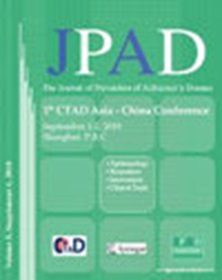双任务训练对认知障碍老年人认知和身体功能的影响;系统综述与荟萃分析
IF 7.8
3区 医学
Q1 CLINICAL NEUROLOGY
引用次数: 10
摘要
背景和目的阿尔茨海默病和痴呆症患者的认知能力下降,体能下降。参与认知挑战和体育锻炼可以有效减少与年龄相关的认知和身体衰退。人们认为,在认知挑战的背景下进行体育活动可能会增强成人大脑的神经发生过程,但这种干预措施的效果如何?是否有足够的证据支持双重任务训练比单独的认知或身体训练更有效?这种训练能在多大程度上改善处于认知能力下降不同阶段的患者的认知和身体功能?方法这篇系统综述和荟萃分析总结了双任务训练增强认知障碍、痴呆或阿尔茨海默病老年人认知和身体功能的新证据。在MEDLINE、PubMed、EMBASE和Cochrane Library中进行了系统检索,检索词如下:随机对照试验、双任务训练、SCD、MCI、痴呆症和阿尔茨海默病。结果共确定了21项研究,2221名参与者。双重任务晒黑干预的结果概括为:整体认知功能的变化;SMD=0.24,(P=0.002),内存;SMD=0.28,(P=0.000),执行功能;SMD=0.35,(P=0.000),注意;SMD=-0.19,(P=0.1),步态速度;SMD=0.26,(P=0.007),双重任务成本;SMD 0.56,(P=0.000),平衡;SMD 0.36,(P=0.004)。结论初步分析显示,双任务训练干预对认知功能有小到中等的积极影响,对步态功能和平衡有中到大的积极影响。本文章由计算机程序翻译,如有差异,请以英文原文为准。
The Effects of Dual-Task Training on Cognitive and Physical Functions in Older Adults with Cognitive Impairment; A Systematic Review and Meta-Analysis
Background and Objective Individuals with Alzheimer disease and dementia experience cognitive decline and reduction in physical capabilities. Engaging in cognitive challenges and physical exercises is effective in reducing age-related cognitive and physical decline. It is believed that physical activity in the context of cognitive challenges might enhance the process of neurogenesis in the adult brain, but how effective are such interventions? Is there enough evidence to support that dual-task training is more effective than cognitive or physical training alone? To what extent can such training improve cognitive and physical functions in patients at various stages of cognitive decline? Methodology This systematic review with meta-analysis summarizes the emerging evidence of dual-task training for enhancing cognitive and physical functions in older individuals with cognitive impairment, dementia or Alzheimer’s disease. A systematic search was carried out in MEDLINE, PubMed, EMBASE, and Cochrane Library with the following search terms: randomized control trials, dual-task training, SCD, MCI, dementia, and Alzheimer’s disease. Results A total of 21 studies with 2,221 participants were identified. The results of dual-task tanning intervention are summarized as change in global cognitive function; SMD = 0.24, (P= 0.002), memory; SMD = 0.28, (P = 0.000), executive function; SMD = 0.35, (P = 0.000), attention; SMD = −0.19, (P = 0.1), gait speed; SMD = 0.26, (P = 0.007), dual-task cost; SMD 0.56, (P = 0.000), and balance; SMD 0.36, (P = 0.004). Conclusion Primary analysis showed a small-to-medium positive effect of dual-task training interventions on cognitive functions and medium-to-large positive effect on gait functions and balance.
求助全文
通过发布文献求助,成功后即可免费获取论文全文。
去求助
来源期刊

Jpad-Journal of Prevention of Alzheimers Disease
CLINICAL NEUROLOGY-
自引率
7.80%
发文量
85
期刊介绍:
The JPAD « Journal of Prevention of Alzheimer’Disease » will publish reviews, original research articles and short reports to improve our knowledge in the field of Alzheimer prevention including : neurosciences, biomarkers, imaging, epidemiology, public health, physical cognitive exercise, nutrition, risk and protective factors, drug development, trials design, and heath economic outcomes.
JPAD will publish also the meeting abstracts from Clinical Trial on Alzheimer Disease (CTAD) and will be distributed both in paper and online version worldwide.
 求助内容:
求助内容: 应助结果提醒方式:
应助结果提醒方式:


